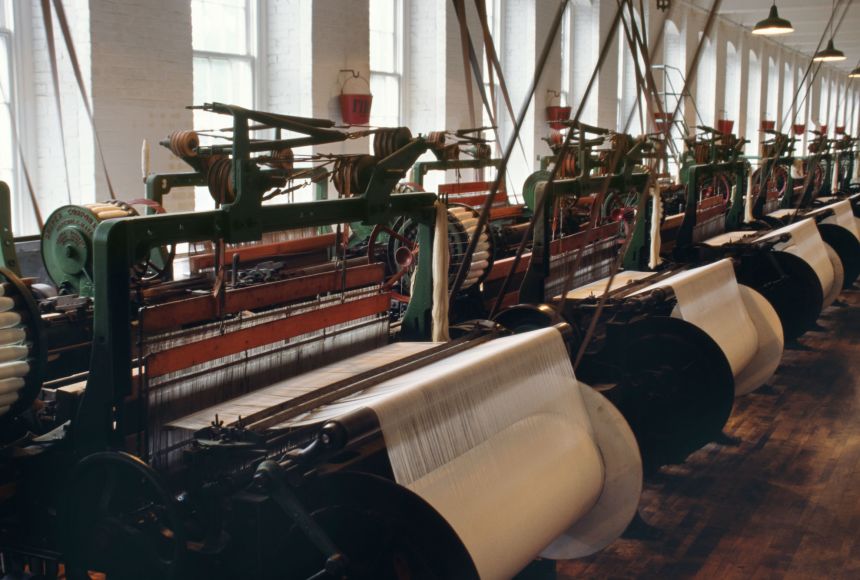The Industrial Revolution is an appropriate name for a period in history where major innovation led to huge worldwide change. This era created changes in business, the work that people did, and society. These shifts continue to affect the world today.
Before the Industrial Revolution, most people in Europe worked either as farmers or artisans making hand-crafted goods. The ways in which people lived had not changed significantly since the Middle Ages. Once industrialization began, however, work and family life would be transformed forever.
Populations Shift fom Farms to Cities
Most historians say that the Industrial Revolution began in Great Britain around 1750. Before this time, people rarely traveled beyond their small villages. Rural people worked as subsistence farmers, meaning they grew crops to feed themselves and their families.
Populations grew during the 18th century and farmers increased food production to feed the larger population. Machines started to be used in farming, so fewer agricultural workers were required. Larger, more advanced farms replaced subsistence farms.
The Industrial Revolution demonstrates the idea of economies of scale. According to this principle, increased production of goods improves overall efficiency. For peasants, the large-scale production of goods such as crops meant fewer opportunities. Conditions further worsened due to the enclosure movement. Previously, villages had common lands that could be used by all villagers. Once large-scale agriculture became widespread, wealthy people bought these lands and used them for private farms.
Due to these shifts, more rural people struggled to survive and many headed for towns and cities to find new jobs. The growth of British cities was further accelerated by the development of factories. Industrial cities such as Manchester and Leeds grew dramatically in just a few decades. In 1800, only one in five Britons lived in a city. By the middle of the 19th century, that number had risen to half. Other Western European nations, including France, the Netherlands, and Germany, also saw an increase in their urban populations.
Factory Jobs Often Meant Family Separations
Factory work in cities differed from farming. Before the Industrial Revolutions, most goods were made by craftsmen, including jewelers and blacksmiths.
The dawn of industrialization came alongside inventions such as the coal-powered steam engine, and the pace of work increased. In factories, coal mines and other workplaces, people worked long hours in miserable conditions. As countries industrialized, factories became larger and produced more goods. Earlier forms of work and ways of life began to disappear.
Perhaps the most harmful consequences of industrialization were those affecting families. Throughout history, most people worked with their families. Married couples and their children often worked together on farms or in shops. In 18th-century Great Britain, women and men performed jobs like spinning wool into textiles and weaving textiles into cloth. This system was called the "putting-out" or domestic system.
Once factories were built, most men no longer worked at home. Some left their families behind in the country for jobs in the city. Sometimes, an entire family moved to the city to remain together. Even when men stayed with their families, factory jobs were so difficult that they had little time to relax and enjoy family life.
Women and Children Took on Dangerous Factory Work
Women also worked outside the home. Unmarried women worked as servants in other families' homes, and many others worked in textile mills. During the first century of industrialization, children worked in factories. Factory owners wanted workers whose fingers were small enough to weave thin threads. Despite their importance and hard labor, women and children received low pay. They were forced to work 16 hours per day or longer. Although their work conditions could be very dangerous, women's jobs were seen as less skilled than those of their male co-workers.
Industrialization caused similar changes in the United States. U.S. manufacturing began after the nation gained independence from England in the 1770s. During his administration from 1801 to 1809, President Thomas Jefferson established a trade embargo. The embargo banned foreign countries from sending products to the United States to trade. This meant Americans had to buy more U.S.-made goods.
During the War of 1812, the British navy blocked ships from sailing in and out of U.S. ports, which further drove the growth of U.S. factories. By the 1830s, the United States was one of the world's leading economic powers.
Industrialization Meant Economic Growth
In the first 50 years after American independence, many farmers moved to factory jobs. As in Great Britain, textile production led the way. Industrialization, along with new inventions in transportation including the railroad, generated economic growth. There was now a large working class, and this would eventually lead to conflict between workers and factory owners. Working men and women led strikes to demand better working conditions.
Starting in the late 1800s and early 1900s, industrialized countries such as Great Britain and the United States passed laws to help workers. However, harsh conditions arose in other parts of the world as it too was industrialized. We continue to live with the Industrial Revolution's effects today.

